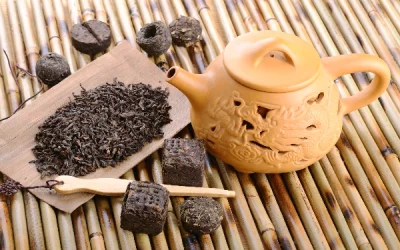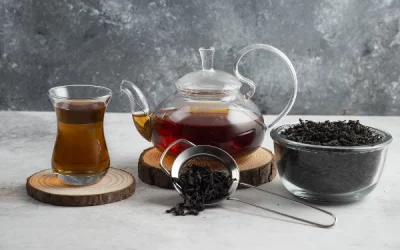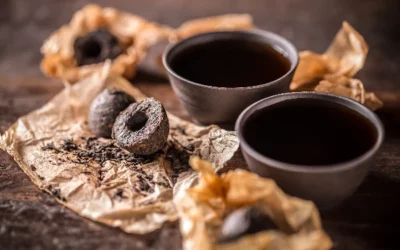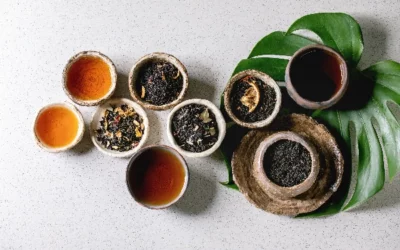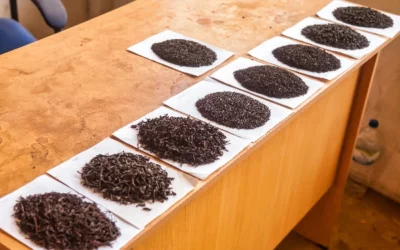Have you ever sipped a cup of tea and wondered about its origins? Enter Lady Grey tea—a delightful twist on the classic Earl Grey that combines fragrant bergamot with hints of citrus. As tea lovers continue to explore unique blends, understanding Lady Grey’s origins, distinct flavours, and health benefits becomes increasingly relevant. This ultimate guide will uncover everything you need to know about Lady Grey tea, from brewing the perfect cup to dispelling common misconceptions. Get ready to elevate your tea experience!
Table of Content
What is Lady Grey tea?
Lady Grey tea is a variation of the popular Earl Grey tea. It is a black tea blend flavored with the oil of bergamot, similar to Earl Grey, but with a milder and more delicate flavor profile. Lady Grey tea typically includes additional ingredients like lemon peel, orange peel, and sometimes lavender, making it lighter and slightly sweeter than Earl Grey.
The addition of these citrus peels gives Lady Grey a refreshing taste with a subtle hint of citrus, which makes it a popular choice for those who find traditional Earl Grey too strong or intense. Lady Grey is often enjoyed on its own, with milk, or with a slice of lemon. It’s a versatile tea that can be served hot or iced, depending on personal preference.
Lady Grey tea was developed by Twinings in the early 1990s and named after Mary Elizabeth Grey, the wife of Charles Grey, the British Prime Minister after whom Earl Grey tea is named.
What distinguishes Lady Grey tea from Earl Grey?
You might wonder how Lady Grey tea stands out from its more famous counterpart, Earl Grey. The differences may seem subtle, but they significantly affect the tea’s overall profile and appeal.
- Flavour Profile: Lady Grey tea features a lighter, more citrusy flavour compared to the robust and floral notes of Earl Grey.
- Ingredients: Lady Grey includes additional ingredients such as lemon peel and orange peel, which are absent in traditional Earl Grey.
- Aroma: The aroma of Lady Grey is more vibrant and zesty, while Earl Grey has a more singular bergamot scent.
- Audience: Lady Grey targets a different demographic, often appealing to those who prefer subtler tea blends.
- Serving: While both teas can be enjoyed with or without milk, Lady Grey is often preferred without milk to let its lighter flavours shine through.
Lady Grey tea provides a gentler, more nuanced tea-drinking experience, making it an excellent option for those who might find Earl Grey’s flavour too overpowering. The added citrus elements bring a refreshing quality to every sip.
Who created Lady Grey tea and when?
Twinings, a renowned tea company with a rich history dating back to 1706, introduced Lady Grey tea. It was created in the early 1990s by Twinings’ master blenders as a response to feedback from tea drinkers who found Earl Grey too strong.
- Company: Twinings
- Creation Period: Early 1990s
- Inspiration: Developed to cater to a younger, more diverse audience
- Master Blenders: Expert tea blenders at Twinings
- Initial Reception: Quickly gained popularity for its unique and refreshing taste
The launch of Lady Grey tea represented Twinings’ ability to adapt and innovate within the tea market, maintaining their status as a leading tea manufacturer while catering to evolving consumer preferences.
Why is Lady Grey tea trademarked?
The trademark status of Lady Grey tea ensures the blend remains unique and proprietary to Twinings. This legal protection allows Twinings to maintain the integrity and quality of the tea, preventing other companies from producing and selling an identical blend.
- Quality Control: Guarantees consistency in flavour and ingredients
- Brand Identity: Helps distinguish Lady Grey as a unique product within Twinings’ range
- Market Advantage: Prevents competitors from replicating the blend
- Consumer Trust: Assures tea drinkers of the authenticity and quality of the product
- Exclusive Rights: Ensures only Twinings can use the specific combination of ingredients and flavours
Trademarking Lady Grey tea safeguards its reputation and ensures that tea enthusiasts receive the genuine product every time they enjoy a cup.
In the 1830s, Charles Grey, the 2nd Earl Grey and British Prime Minister, received a gift of tea flavoured with bergamot oil. The tea was named after him, becoming the famous Earl Grey.
Lady Grey, his wife, appreciated a lighter touch, leading to the creation of Lady Grey tea much later. This historical inspiration aligns with the modern blend, honouring Lady Grey’s preference for a milder, more citrusy tea.
I remember my first encounter with Lady Grey tea. I was in a quaint tea shop, overwhelmed by the options. The shopkeeper recommended trying Lady Grey. The light, citrusy aroma hooked me immediately.
The delicate flavour was a refreshing surprise, a perfect balance of zest and comfort. Since then, it has been my go-to tea for a calming afternoon break. It’s a small joy that brings a touch of elegance to my day.
What are the key ingredients in Lady Grey tea?
Lady Grey tea, a delightful and aromatic blend, is a popular variant of the well-known Earl Grey tea. This tea is famous for its unique citrusy twist, making it a favourite among tea enthusiasts. To understand what makes Lady Grey tea so special, it’s essential to dive into its key ingredients.
Lady Grey tea combines a blend of black tea with additional citrus elements, creating a refreshing and light flavour profile. The tea’s distinct taste comes from its carefully selected ingredients, each contributing its unique characteristics. Below, you’ll find a table that breaks down the main ingredients, their origins, and their roles in flavour. This table will help you appreciate the complexity and thoughtfulness behind Lady Grey tea’s composition.
| Ingredient | Origin | Role in Flavour |
|---|---|---|
| Black Tea | India, China, Sri Lanka | Provides the robust base flavour |
| Bergamot Oil | Italy, France | Adds a fragrant, citrusy note |
| Lemon Peel | Mediterranean Region | Enhances the citrus flavour |
| Orange Peel | Spain, USA | Adds sweetness and a zesty aroma |
| Cornflower Petals | Central and Eastern Europe | Provides a mild floral undertone |
| Lime Peel | Mexico, Brazil | Adds a tangy and refreshing twist |
| Natural Flavouring | Various sources | Balances and enhances overall taste |
When using this table, note the diverse origins of the ingredients, which contribute to the tea’s global and complex nature. Each ingredient plays a specific role in creating the refreshing and well-balanced flavour profile that defines Lady Grey tea.
Black tea
Black tea serves as the base of Lady Grey tea. Sourced from regions such as India, China, and Sri Lanka, it offers a robust and rich foundation. The strong, full-bodied taste of black tea is essential in balancing the lighter, citrusy notes of the additional ingredients.
- Full-bodied and robust flavour
- Grown in various regions including India, China, and Sri Lanka
- Provides the base for many flavoured teas
- Rich in antioxidants and caffeine
The black tea leaves are often chosen for their ability to blend well with the bright, citrusy elements, creating a harmonious cup that is both invigorating and smooth.
Citrus elements
The citrus elements in Lady Grey tea, including bergamot oil, lemon peel, orange peel, and lime peel, are what set it apart from its cousin, Earl Grey tea. These ingredients provide the tea with its distinctive fruity and tangy flavour.
- Bergamot oil from Italy and France adds a fragrant citrus note
- Lemon peel from the Mediterranean region enhances the citrus flavour
- Orange peel from Spain and the USA adds sweetness and a zesty aroma
- Lime peel from Mexico and Brazil adds a tangy and refreshing twist
These citrus elements are carefully balanced to ensure the tea remains bright and refreshing without becoming overly tart or bitter.
In the world of tea, many fascinating stories abound. One such tale revolves around Charles Grey, the 2nd Earl Grey, after whom Earl Grey tea is named. It is said that a Chinese mandarin presented him with a tea recipe as a gesture of gratitude after one of Lord Grey’s men saved his son from drowning.
The blend of tea with bergamot oil soon became a household favourite in Britain, and eventually, Lady Grey tea was developed as a milder, more citrusy variation, appealing to those who found traditional Earl Grey too strong.
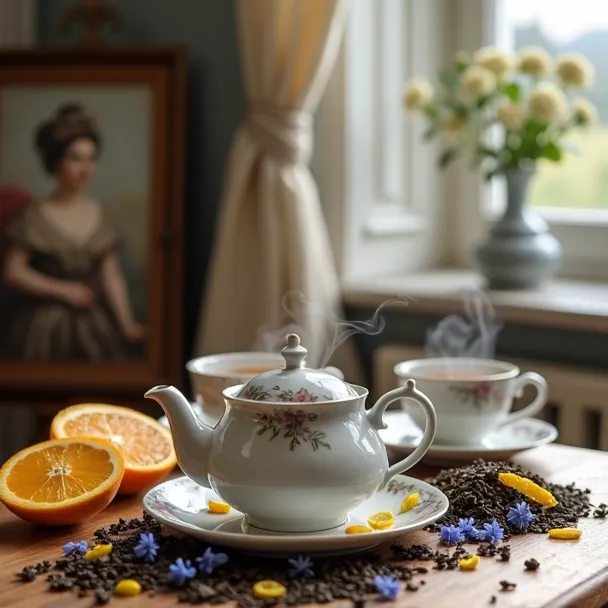
How does Lady Grey tea differ in taste from Earl Grey?
If you’ve ever sipped Lady Grey tea and wondered how it differs from its well-known cousin, Earl Grey, you’re in the right place. Imagine Earl Grey as a sophisticated gentleman in a crisp suit, while Lady Grey is his slightly softer sister, wearing a flowery dress with citrus accents. Both are delightful in their own ways, but Lady Grey has a bit more zing.
Now, let’s dissect this further. Earl Grey is known for its bold flavour and unmistakable bergamot aroma, which can sometimes be overwhelming. Lady Grey, on the other hand, adds a gentler citrus twist with the inclusion of orange and lemon peel.
This subtle twist makes Lady Grey’s taste lighter and more refreshing. We’re talking about a tea that caters to those who want a fragrant experience without being slapped in the face by bergamot.
What are the primary flavour notes in Lady Grey tea?
When you take your first sip of Lady Grey tea, you’re greeted with a delightful mix of subtle flavours. It’s not just a random collection of tastes; it’s a carefully curated symphony for your taste buds.
- Citrus: The stars of the show are the orange and lemon peels, adding a unique freshness.
- Bergamot: A toned-down version compared to Earl Grey, offering a less assertive floral-citrus hint.
- Black tea: A robust backbone that provides a rich and full-bodied experience.
- Cornflowers: Sometimes added for an added mild sweetness and visual appeal.
These primary notes combine to create a tea that’s light, bright, and delightful.
By blending these flavours, Lady Grey appeals to those who enjoy both the refreshing taste of citrus and the robustness of black tea. It’s a tea that’s equally comfortable at an afternoon tea party as it is as a morning wake-me-up.
How do consumers perceive the taste difference?
Consumer perceptions vary, but several common themes emerge when comparing Lady Grey and Earl Grey. Here’s what tea enthusiasts generally think:
- Less bitter: Many find Lady Grey to be less bitter than Earl Grey, thanks to the added citrus notes.
- Lighter aroma: The aroma of Lady Grey is more subdued, making it less likely to overpower other flavours when paired with food.
- Smooth aftertaste: Lady Grey is praised for its smooth, less lingering aftertaste compared to Earl Grey.
- Balanced flavour: The blend of black tea and citrus is considered more balanced and harmonious.
So, if you’ve ever found Earl Grey a bit too punchy, Lady Grey offers a milder alternative without sacrificing that distinctive citrus flair.
Are there any common misconceptions about the taste?
Misconceptions can lead to unrealistic expectations, and when it comes to Lady Grey tea, there are a few myths floating around:
- “It’s just a lighter Earl Grey”: While it’s softer, it’s not just a diluted version. The citrus additions mean it brings something new entirely.
- “It’s the same as every flavoured tea”: Lady Grey stands out with its particular citrus-and-bergamot blend. It’s not your run-of-the-mill lemon or orange tea.
- “Only for people who dislike Earl Grey”: Not true. Many people enjoy both for different occasions; it’s about preference and mood, not a binary choice.
- “It’s a sissy tea”: Don’t be fooled by the “lady” in its name. It’s still a robust tea, just with a touch of elegance.
Lady Grey is its own unique blend, and these misconceptions shouldn’t deter you from giving it a try.
How can you brew the perfect cup of Lady Grey tea?
Ah, Lady Grey tea, the posh little cousin of Earl Grey that’s like a refreshing breeze on a summer day. Here’s how you can brew the perfect cup of this citrusy delight. First things first, with water temperature, be spot-on.
Too hot, and you’ll scorch those delicate leaves; too cool, and you won’t get the full bouquet of flavours. Then, there’s steeping time. Get it right, and you’re in flavourtown; get it wrong, and it’s like sipping on wilted cardboard.
Finally, make sure to savour it correctly, because what’s the point of brewing the perfect cuppa if you don’t pair it with the right treats?
Water temperature and steeping time are the linchpins here. Understand these, and you’re already halfway to tea nirvana. Let’s break it all down, step by step, so you can brew a cup that would make even a tea sommelier nod in approval.
What is the ideal water temperature for brewing?
The magic number is 90°C (194°F). Boiling water is a no-no; it’s the equivalent of trying to make friends by shouting at them—overkill. Here’s what to keep in mind:
- Use filtered water, because nobody likes a cup of tea that tastes like the aftermath of a plumbing accident.
- Boil your water, then let it cool for about a minute to reach that optimal 90°C.
- If you’ve got a fancy kettle with temperature settings, this is the time to gloat and use it.
By following these steps, you allow the tea leaves to release their full complexity without any bitterness stealing the show.
How long should you steep Lady Grey tea?
Steeping time is crucial. Too short, and it’s like licking a lemon rind; too long, and it’s a bittersweet horror show. Aim for about 3 to 5 minutes. Here’s a simple guide:
- For a light, refreshing taste, steep for 3 minutes.
- For a richer, more robust flavour, go for up to 5 minutes.
- Avoid going beyond 5 minutes unless you enjoy drinking regrets.
A good rule of thumb: Keep an eye on the clock. Oversteeping is the tea world’s equivalent of burning toast—nobody wants that.
Are there any recommended pairings for Lady Grey tea?
Indeed, there are! What’s a magnificent brew without some scrumptious sides to keep it company? Lady Grey tea is versatile and can pair with both sweet and savoury delights:
- Lemon scones—because why not add more citrus to your citrus?
- Shortbread biscuits—classic choice, buttery and understated.
- Blueberry muffins—the light sweetness complements the tea’s floral notes.
- Soft cheeses—provides a nice contrast to the tea’s bright flavours.
- Strawberries with clotted cream—if you’re feeling particularly indulgent.
Choosing the right complements can elevate your tea-drinking experience from ordinary to extraordinary.
Brewing Lady Grey tea is almost like painting a masterpiece. Each step—from selecting the perfect water temperature to timing the steep—adds to the final masterpiece in your cup. And remember, the right pairings enhance the overall experience, making it something to look forward to.
Once upon a time, Lady Grey herself, née Mary Elizabeth Grey, devised this particular blend to soften the robust and tangy notes of the original Earl Grey. She wanted something that wouldn’t frighten away her less adventurous house guests.
Her clever concoction, with its addition of Seville orange, lemon peel, and bergamot, was a hit at social galas. Little did she know that this elegant tea would become a staple of refined tea parties worldwide, giving everyone from royalty to tea lovers like you a taste of elegance in every sip.
What are the common misconceptions about Lady Grey tea?
Lady Grey tea – sounds fancy, doesn’t it? But along with that posh name comes a suitcase full of myths and misunderstandings. Let’s slice through the confusion like a hot knife through butter.
People often think Lady Grey is just a jazzy alternative to Earl Grey, but it’s a distinct member of the tea family with its own quirks and qualities.
Some say it’s caffeine-free, others believe it’s an exact match in ingredients no matter the brand. And don’t even get me started on the whole jest of it being a lesser sibling to Earl Grey. Let’s disentangle these tea leaves, shall we?
Is Lady Grey tea always caffeine-free?
Short answer: Nope, it’s not.
You might come across ladles of Lady Grey tea labelled caffeine-free, but be cautious. Most Lady Grey teas are like any other black tea – they come packed with a modest jolt of caffeine to help you start the day. Of course, there are decaffeinated versions, but assuming all Lady Grey is caffeine-free is like assuming all cookies are low-calorie (spoiler alert: they aren’t).
- Regular Lady Grey has a caffeine level comparable to most black teas.
- If you’re looking to go caffeine-free, hunt for the decaf version.
- Drinking it in moderation can still provide a gentle energy boost.
- Its citrus flavour profile doesn’t change with the decaf tag.
- Not all brands offer a decaffeinated option, so read those labels.
Don’t be deceived by the term “Lady” in Lady Grey. She might be elegant, but she’s got a zing to make sure you’re not nodding off like a dormant sloth.
Are all Lady Grey teas made with the same ingredients?
No, they aren’t; inconsistency is the name of the game.
Various brands bend the concept of authenticity to their liking. The traditional recipe calls for black tea leaves blended with lemon peel, orange peel, and bergamot oil. But, as with any product, add a pinch of marketing magic and voilà – you have a hundred “authentic” Lady Greys.
- Basic ingredients include black tea, lemon peel, orange peel, and bergamot oil.
- Some add extra flowers like cornflowers for visual appeal.
- Differences arise in the quality and origin of tea leaves.
- Flavour strength can vary significantly from brand to brand.
- Artificial flavouring – some do, some don’t. Watch out for it!
A cup of Lady Grey from Brand A might have you savouring delicate citrus notes, while Brand B might pack a punch strong enough to wake a comatose koala. Check ingredient lists if picky about your brew.
Why do some people confuse Lady Grey with Earl Grey?
Probably because they’ve never been properly introduced.
The key distinction is Lady Grey’s added zest. Both share bergamot oil, the cornerstone of the “grey” family, but Lady Grey goes a step beyond, mingling lemon and orange peels. Each has its unique charm, but lumping them together is like saying coffee and mocha are the same (heresy, I tell you!).
- Earl Grey = Black tea + bergamot oil.
- Lady Grey = Black tea + bergamot oil + lemon peel + orange peel.
- Earl Grey has a robust, somewhat singular flavour.
- Lady Grey boasts a lighter, more citrus-centric profile.
- Both suit different moods and times – Earl Grey for a punch, Lady Grey for a subtle nudge.
Think of it this way: Earl Grey is the classic tuxedo, and Lady Grey is the elegant summer dress. Both classy, but they belong in different seasons.
So next time you sip, be it Lady or Earl, give a nod to the innovative Lady Grey whose genteel cup you’ve inherited. Properly cultured, aren’t we?
What variations of Lady Grey tea are available?
If you think you’ve tried all the flavours of tea the world has to offer, let me introduce you to the smorgasbord of Lady Grey tea variations. Gone are the days when tea was just a murky liquid in your cup. Now, tea connoisseurs like you can dive into a multitude of Lady Grey tea versions, each one a twist on the classic blend of black tea, bergamot, lemon, and orange.
Imagine wandering through a tea aisle, and you’ll find Lady Grey in more flavours than you ever thought possible. These variations include everything from floral undertones to spicy hints and seasonal sensations that appear like magic during festive times. Brands have capitalised on the popularity of Lady Grey tea, presenting their own unique spin that’s both intriguing and deliciously confusing.
What are some popular variations of Lady Grey tea?
Alright, let’s cut to the tea chase—what are some popular versions of this marvellous concoction?
- Traditional Lady Grey: The OG blend with black tea, bergamot, lemon peel, and orange peel.
- Lavender Lady Grey: Adds a floral twist—lavender for the fancy folk.
- Citrus Lady Grey: Extra lemon and orange zest for those who can’t get enough citrusy goodness.
- Spicy Lady Grey: Infused with a hint of cinnamon and cloves for a wintery kick.
- Vanilla Lady Grey: Smooths things out with a creamy, vanilla flavour.
Here’s the kicker—some brands have gone absolutely wild with their own variations! Twinings, the brand that popularised Lady Grey tea, will often tinker with the blend for seasonal collections and limited editions. So if you’re a collector—or just have a fear of missing out—keep your eyes peeled for those special releases.
How do these variations change the flavour?
Now let’s talk taste. What happens when you throw lavender or vanilla into the mix?
The variations each add their own unique twist:
- Lavender Lady Grey: Offers a calming floral aroma and taste, making you feel like you’ve been transported to a French lavender field.
- Citrus Lady Grey: Cranks up the zesty notes to refresh your palate. It’s like drinking sunshine.
- Spicy Lady Grey: Adds warmth and depth, perfect for sipping by the fireplace on a chilly day.
- Vanilla Lady Grey: Introduces a subtle sweetness and creamy texture. Imagine a tea version of a vanilla latte but fancier.
Each new ingredient harmonises with the base notes of bergamot and citrus, creating a layered flavour experience. Some versions might feel like a warm hug, while others are like a zesty wake-up call.
Are there any limited edition Lady Grey teas?
Oh, the joy of limited editions! They’re the collector’s Holy Grail and the tea lover’s delight. Brands often release seasonal Lady Grey tea versions that you won’t find year-round.
- Christmas Spice Lady Grey: Only available during the festive season, adding nutmeg, cinnamon, and a bit of magic.
- Spring Blossom Lady Grey: Released in spring, with hints of cherry blossoms and added floral notes.
- Summer Citrus Lady Grey: Limited to sunny seasons, with intensified lemon and lime zest.
- Autumn Harvest Lady Grey: A fall-special with additional spices like cardamom and hints of apple.
The catch? If you love one of these, you’ll have to wait until it rolls around again—or hoard it like there’s no tomorrow.
Back in the 1830s, Charles Grey, the 2nd Earl Grey, might have missed out on Lady Grey tea, but his legacy lives on in these beautiful tea variations. He was given a gift of tea flavoured with bergamot oil, which later inspired the creation of Earl Grey and, down the line, Lady Grey.
If only he could see how far his simple blend has come! Now, our tea shelves are brimming with creative iterations while staying true to some old-world charm.
Conclusion
Reflecting on the delightful journey through the world of Lady Grey tea, I’ve come to appreciate its unique charm and character, distinct from its more famous counterpart, Earl Grey.
Originating from a historical context, its trademark status and specific ingredient variations set it apart, embodying a sophisticated blend embraced by an eager audience of tea enthusiasts and casual drinkers alike.
We’ve uncovered the key ingredients that contribute to its enchanting flavour profile, with citrus notes dancing harmoniously alongside traditional black tea, enhancing our understanding of why this tea captivates our senses.
The health benefits linked to Lady Grey tea, from its antioxidant properties to its digestive aids, further illustrate why it deserves a cherished spot in our tea collections.
The balance of caffeine also positions it as an excellent choice for those seeking a moderate pick-me-up without overindulgence. Mastering the brewing techniques guarantees that we experience the full spectrum of flavours and aromas, turning each cup into a ritual worth savouring.
As we’ve seen, the marketplace is ripe with options, from reputable brands to organic selections. However, navigating through common misconceptions and a plethora of variations can be daunting. It’s crucial to uncover the truth behind the myths and embrace the diverse world of Lady Grey tea.
In light of all this, I encourage you to explore further. Whether you’re a long-time lover of Lady Grey or just beginning your journey, consider trying new blends or revisiting the classic brew with a fresh perspective.
After all, every sip of Lady Grey tea invites us to pause, breathe, and embrace the moment. As the saying goes, “Tea is the magic key to the vault where my brain is kept.” So, I leave you with this thought: what will your next cup of Lady Grey reveal to you?
Resources
- A Narrative Review of the Effects of Citrus Peels and Extracts on Human Brain Health and Metabolism
- Antioxidant Activity of Black Tea vs. Green Tea
- Molecular evidences of health benefits of drinking black tea
- Tea Compounds and the Gut Microbiome: Findings from Trials and Mechanistic Studies
- Biological potential and mechanisms of Tea’s …
- Antioxidant effects of tea: evidence from human clinical trials


